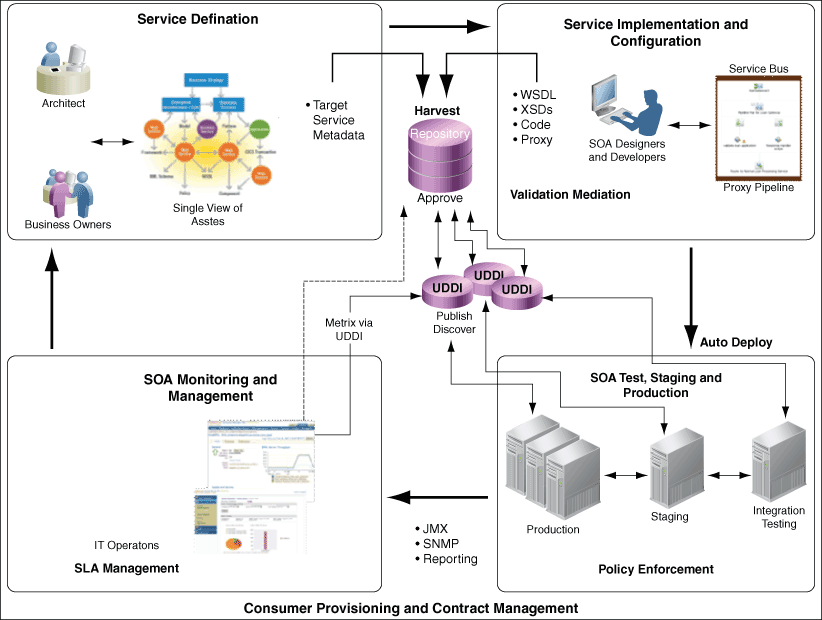| Oracle® Fusion Middleware Quick Start Guide for Oracle Enterprise Repository 11g Release 1(11.1.1) Part Number E16581-01 |
|
|
View PDF |
| Oracle® Fusion Middleware Quick Start Guide for Oracle Enterprise Repository 11g Release 1(11.1.1) Part Number E16581-01 |
|
|
View PDF |
The fourth step in getting started with Governance is to identify initial Governance stakeholders.
This chapter contains the following sections:
Now that you've identified the assets that should be governed, it's time to work with the stakeholders to:
Determine how they can best leverage the Enterprise Repository
Identify additional metadata required by stakeholders
Modify taxonomies/categorizations
Customize/tailor each stakeholder's access to and views of assets
Figure 4-1 Closed Loop Governance Process

Figure 4-1 provides an overview of some of the stakeholders that participate in the closed loop governance process. This process is supported by the governance infrastructure.
The following description of common stakeholders in the closed-loop governance process, and the typical Roles assigned to them in the Oracle Enterprise Repository.
For information about establishing Users in Oracle Enterprise Repository, see "Users" in Oracle Fusion Middleware Configuration Guide for Oracle Enterprise Repository.
For information about assigning Roles to Users, see "Roles" and "Access Settings" in Oracle Fusion Middleware Configuration Guide for Oracle Enterprise Repository.
Oracle has a perspective on some of the characteristics of best-of-breed Governance solutions. For more information about Governance structures, see the OFRA Governance material at
http://www.oracle.com/technology/products/soa/repository/index.html
This section describes the various Oracle Enterprise Repository solution packs available:
Identify common needs across the community.
Identify assets and levels of investment needed to fulfill those needs.
Determine the expected return on asset investments.
Manage the asset lifecycle, from initial inception, creation, distribution, usage all the way through to retirement.
Define common functionality in the Enterprise Repository.
Create an asset in Oracle Enterprise Repository
Populate definitional metadata
Attach relevant documentation
Identify a target availability date
Establish Governance workflows for their portfolio of assets
For more information about workflows, see "Configuring Oracle Enterprise Repository Workflow" in Oracle Fusion Middleware Configuration Guide for Oracle Enterprise Repository.
Participate in the Governance approval process for assets in their portfolio.
Evaluate the performance of their assets by reviewing usage history, developer feedback, runtime performance metrics, policy status, and compliance reports.
Use the Oracle Enterprise Repository Navigator to evaluate the impact should they change or modify their assets
Create new versions of existing assets, and retire old versions.
Typical Roles Assigned in Oracle Enterprise Repository
Registrar
Specify global business requirements
Reuse existing business processes
Structure new business processes using existing capabilities and services
Drive revenue by extending business processes to trading partners
Typical Roles Assigned in Oracle Enterprise Repository
Advanced Submitter
Analyze and search software assets to design a project architecture that maximizes appropriate reuse (SLA for services, maturity of components, design document
Create and use applications, services and component versions
Notify stakeholders of changes to applications, services and components
Typical Roles Assigned in Oracle Enterprise Repository
Advanced Submitter
Analyze and search software assets for specific reuse (features, dependencies, how to guides, test harness)
Use applications, services and component versions
Notify stakeholders of changes to applications, services and components
Use reusable assets in the creation of other assets
Search repository for suitable reusable assets for projects
Integrate reusable assets, with additional responsibility for engineering or modifications made necessary by the integration
Typical Roles Assigned in Oracle Enterprise Repository
User
Creates reusable assets from scratch and/or reengineers existing assets to be reusable
May be responsible for testing assets and ensuring quality standards are met
May be responsible for maintaining assets and helping users understand asset functionality, features, limitations, and applicability
Typical Roles Assigned in Oracle Enterprise Repository
Advanced Submitter
Assess, certify, classify, add, and delete assets from the repository
May be responsible for maintaining the operational aspects of the repository
Ensures that work products meet quality, documentation, and other established standards.
May communicate new work product additions or deletions to all constituents.
Match consumer engineer needs with producer engineer capabilities and availability.
Typical Roles Assigned in Oracle Enterprise Repository
Registrar
Track progress toward the target architecture
Communicate progress to the executives
Communicate architectural standards to delivery teams
Monitor compliance.
Typical Roles Assigned in Oracle Enterprise Repository
Registrar
Coordinates planning, prioritization, monitoring, and support of the governance program, while aligning it with changing business needs.
Facilitates the definition of the program objectives
Oversee all aspects of the enterprise initiative.
Establish consensus and promote the program goals and objectives, including schedules, budget, key milestones, and deliverables.
Co-develop, review, and integrate the supporting project plans.
Development of communication plans, risk management plans, and skill gap analysis.
Provide regular updates to senior management, customer representatives and program participants.
Establish metrics and reporting requirements.
Typical Roles Assigned in Oracle Enterprise Repository
Registrar Administrator
Analyze and search reuse and the contributions of applications, components, services by LOB, product, value chain
Typical Roles Assigned in Oracle Enterprise Repository
User
An individual or group representing management and its interests
Authorizes, encourages and supports the use of resources
Provides visibility that management supports the program
Typical Roles Assigned in Oracle Enterprise Repository
User
Program support and evangelism throughout every level of the organization
Educates others on the program concepts, its long-term benefits, its inhibitors, and the motivation behind its implementation
Sets direction for the effort and implementation
Communicates successful efforts throughout the organization
Typical Roles Assigned in Oracle Enterprise Repository
User